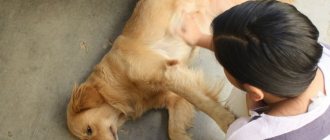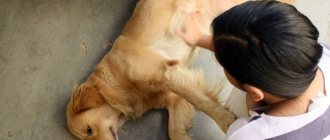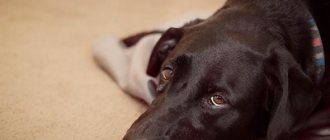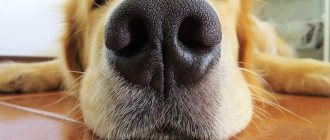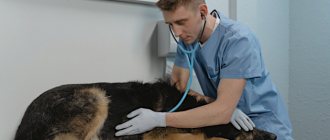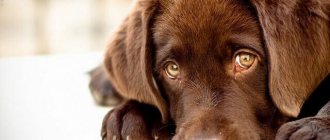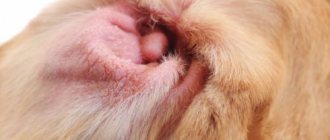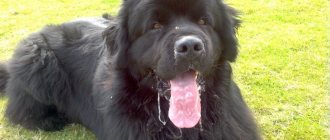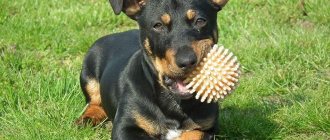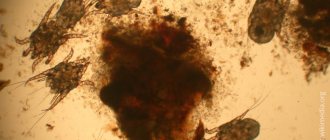One of the signs of a dog’s health is regular stool with well-formed, moderately soft and moist feces. The normal frequency of bowel movements is 2-4 times a day. If the animal defecates more often, the stool is watery, green, or contains mucus or blood, it has diarrhea. This is a fairly common disease in dogs. Owners should know what to do if an upset stomach occurs, what medications to give, how to help the pet and prevent the condition from worsening. Not all official and traditional medicine used to treat people are suitable.
Causes
There are various possible causes of diarrhea in adult dogs and puppies. Some are quite harmless, and diarrhea, even without treatment, goes away on its own in 1-2 days, others require dietary adjustments and careful care, and others are treated with antibiotics, which are prescribed by a veterinarian after examination and diagnosis. And sometimes diarrhea is a symptom of dangerous diseases in which the dog requires emergency veterinary care.
The most common causes of stomach upset in dogs are:
- low quality feed;
- binge eating;
- eating inappropriate foods, foreign objects;
- change of feed;
- allergy to some ingredient in the food;
- taking medications;
- helminth infection;
- viral infections;
- stress;
- lack of minerals and vitamins;
- age-related problems with the functioning of the stomach;
- chemical poisoning;
- neoplasms;
- dysbiosis.
Treatment and prevention
If you are sure that the animal is not sick, and there are no other symptoms other than diarrhea, then you can help your pet at home. The first thing to do is to ensure plenty of drinking and frequent walking, and, of course, do not scold the dog if it “could not bear it.” You can also take the following preventive measures to ensure that your pet rarely or never experiences diarrhea:
- Keep a close eye on your animal while walking. Do not let him pick up food and foreign objects on the street, dig through the garbage, or take something from strangers;
- Do not feed your dog non-recommended foods. Remember that not all food is equally beneficial for both people and animals. Fatty, fried, smoked foods can upset the digestive system. It is also undesirable to overfeed the dog and feed it long bones, pork meat, etc.;
- Vaccinate your pet in a timely manner and regularly carry out deworming (a set of therapeutic and preventive measures to combat helminths);
- feed the animal high-quality, fresh food;
- remove away all small objects and things that the dog can chew and swallow. It is worth paying attention to education. Prohibit your animal from gnawing or chewing any foreign objects.
What should you be wary of?
Diarrhea can be an independent disease that can be successfully treated at home, or a symptom of more dangerous diseases. This is indicated by a change in the color of the stool, the appearance of mucus and even a small amount of blood in it, severe vomiting, and a sharp increase or decrease in body temperature. A dangerous symptom that requires an urgent trip to the veterinarian is the presence of mucous discharge from the nose and eyes.
If your pet suffers from diarrhea, you need to rule out viral infections (some of them can lead to the death of the animal, others pose a danger to humans), chemical poisoning (did the pet pick up food from the ground while walking or was it fed by ill-wishers) and internal bleeding . They can be caused by ingestion of sharp objects and certain diseases.
The dog has yellow diarrhea with mucus: Moscow, choice of clinic
We have selected a list of good veterinary clinics for Muscovites and residents of the capital:
- Medvet . Network of clinics. Branch ave. Vernadsky, 89, bldg. 6. Winner of the Golden Scalpel veterinary award. An appointment with a therapist costs about 1,300 rubles.
- White Fang . Network of clinics. One of the branches is Mitinskaya Street, building 55, building 1. They work around the clock. There is a doctor on call at home, which is important if it is not possible to transport the dog to the doctor. An appointment with a therapist costs about 1,500 rubles, and a gastroenterologist costs 2,800 rubles.
- Zoostatus . Varshavskoe highway, 125, building 1. Works around the clock. An appointment with a therapist costs about 1,500 rubles. There is a specialist gastroenterologist, the cost of which is about 2000 rubles.
- Biocontrol . Kashirskoye sh., 24, building 10. Appointment with a therapist: 1,500 rubles. The clinic provides a pet taxi service, which is undoubtedly very convenient.
- Your doctor . Network of clinics. There are about 120 veterinary specialists on staff, including 12 candidates of veterinary sciences. Appointment with a general specialist costs 900 rubles, and a specialized specialist costs about 1,500 rubles.
- Komondor . Moscow region, Rublevo-Uspenskoe highway, Gorki-2 village, no. 45. In addition to the presence of a gastroenterologist, the clinic has a rehabilitation building with a swimming pool, fitness and massage. Works around the clock.
These clinics follow the principles of evidence-based veterinary medicine in their work and have a large number of highly specialized specialists on staff, which is very convenient. They have all the necessary equipment for timely diagnosis and assistance to your pet.
These clinics also have many positive reviews. The owners note the high professionalism of the specialists and the quick provision of assistance. For example, at Biocontrol an animal can undergo medical examination in just an hour.
Uncomplicated diarrhea
The first thing you need to do when you discover that your pet has diarrhea is to make sure that it is uncomplicated and can be treated at home. The following symptoms are typical for uncomplicated diarrhea:
- stool more than 4-5 times a day;
- thin or watery stool consistency;
- gurgling in the stomach;
- the dog whines when he defecates;
- apathetic or agitated behavior;
- refusal of food;
- thirst.
In this case, the dog’s diet is adjusted, tablets for diarrhea are given and the opportunity to drink clean water without restrictions. A diet for indigestion is necessary for 3-4 days after the diarrhea has stopped.
To normalize digestion, dogs are prescribed homeopathic medicines, which are presented in our online store:
note
Quick view
LIARSIN homeopathic medicine for the correction of metabolic processes, prevention and treatment of diseases of the gastrointestinal tract, solution for injection (10 ml)
10 ml
328 ₽
Show all offers
Quick view
PANCREALEX homeopathic medicine for the treatment of diseases of the gastrointestinal tract, solution for injection (10 ml)
10 ml
337 ₽
Show all offers
If after 3 days the stool has not returned to normal, or the pet continues to diarrhea, a veterinarian’s consultation is necessary. Treatment with strong antibiotics can only be prescribed by a doctor.
Carrying out diagnostics
To determine the cause of the illness and the condition of the internal organs, the pet will have to undergo a comprehensive diagnosis. It includes the following research methods:
- stool analysis, which helps detect toxins or other dangerous substances;
- urine analysis to determine problems in the genitourinary system;
- a blood test necessary to detect deviations in baseline indicators;
- Ultrasound, detecting inflammation, neoplasms and stones;
- X-ray showing pathological changes in internal organs;
- liver biopsy, determining the presence of malignancy of the tumors found.
With timely treatment, all of these diseases can be treated. Even cirrhosis turns out to be reversible, but only at an early stage - when only a small part of the hepatocytes is damaged.
What to feed a dog with diarrhea?
If your pet is diarrhea, it should not be fed for 24 hours. This will help stop the disorder that occurs, regardless of the cause. Even if a dog is vomiting water, this is not a reason to give it dry food or other usual food, much less treats, when it refuses to eat.
Once the cause of loose stool has been determined and it has become soft and not runny, you can give your pet light food. This can be rice in water or light beef or chicken broth. To restore the microflora of the gastrointestinal tract, high-quality, but not fatty, fermented milk products are useful. Then you can add hard-boiled eggs and lean boiled meat to your diet.
For recurring disorders and chronic diseases, add special feed additives to your pet's diet. You can purchase the drugs here:
note
Quick view
BIOCORRECTOR RD food additive for dogs for the prevention of gastrointestinal diseases, increasing immunity and allergies (90 tablets)
90 tablets
145 ₽
Show all offers
Quick view
PRO-KOLIN feed additive for the correction of digestive system disorders (15 ml)
15 ml 30 ml 60 ml
15 ml
to order
Show all offers
If soft stools appear when changing the diet, owners should know how to stop diarrhea from dry food. If it has just appeared in your diet, return to your normal diet for a while. Make sure that the food is not expired or spoiled and does not contain harmful or dangerous substances.
Greyish with a greasy appearance
If your dog's stool is slightly grayish in color and really slimy, oily, or greasy, then your dog may have exocrine pancreatic insufficiency. They call it exocrine to distinguish it from the endocrine function of the pancreas, which is mainly its ability to produce and secrete insulin and glucagon to regulate the metabolism of carbohydrates and other substances in the body. The exocrine function of the pancreas is directly related to its ability to produce and secrete digestive enzymes such as lipases, amylases, and proteases, which digest fats, carbohydrates, and proteins, respectively.
We mentioned above that as food passes through the duodenum, it fills with fluids from the liver, gallbladder and pancreas. The gallbladder secretes bile salts into food so that the fat in food can be adequately coated. This makes them relatively easy to digest by pancreatic lipases. If there is a problem in either of these two mechanisms, or even both, then the fat contained in food is not digested properly and is not absorbed into the blood. Instead, these fats will pass through the intestines, rectum, and anus, causing oily or greasy stool.
Some of the most common conditions that can cause exocrine pancreatic insufficiency in dogs can include pancreatic cancer, cystic fibrosis, and even chronic pancreatitis. If the underlying problem is the release of bile salts, then possible causes may include gallstone formation and extensive liver damage.
Other potential canine conditions that can cause steatorrhea—fatty feces—include intestinal malabsorption secondary to giardiasis, inflammatory bowel disease, overgrowth or harmful bacteria, and even celiac disease, although the latter condition is very rare in dogs.
What to do if your puppy has diarrhea?
Due to age, puppies experience diarrhea more often than adult dogs. Many owners, when faced with loose stool in their baby for the first time, get scared and don’t know what to do. It is necessary to evaluate his condition, the presence of dangerous symptoms, such as bloody, black, green or yellow loose stools, and how frequent they are.
If diarrhea is not complicated by a change in the color of the stool, there is no frequent vomiting, blood and mucus, do not let the baby eat for several hours, offer water or rice water, you can give an activated charcoal tablet or anti-diarrhea powder as recommended by a doctor.
Couldn't you stop the diarrhea in 1-2 days? Don’t know what remedy to give for green diarrhea? Visit a veterinarian - only he can rule out parvovirus enteritis and other dangerous causes of diarrhea, prescribe medications and diet. If there are several puppies in the house, ensure that the animal that has frequent soft or loose stools is isolated until complete recovery.
White and chalky or brown with white speckles
If you see white specks in your dog's feces, these could be the eggs of certain intestinal parasites that have passed through the feces. However, if your dog's feces are whitish in color or perhaps even look chalky, then there is a high chance that your dog may be suffering from hypercalcemia, or a condition in which excessive amounts of calcium are released into the bloodstream. This can occur with bone fractures or any other type of bone injury because the calcium released by the bone matrix must be reabsorbed into the bloodstream.
© shutterstock
Diarrhea and vomiting: possible causes
If your dog has diarrhea and also vomits, especially repeatedly, and has a fever, you should not put off visiting the veterinarian.
Causes of vomiting and diarrhea:
- overeating - one-time or short-term vomiting is observed;
- food poisoning - may vomit several times;
- entry of a foreign body - a characteristic sign is profuse foamy vomiting, sometimes with blood;
- poisoning with chemicals, including inhalation, for example, if something was painted in the apartment or near the enclosure;
- switching to new food;
- helminthiasis - vomits immediately after feeding;
- parvovirus enteritis - the disease is observed mainly in animals aged 2 to 6 months, the puppy vomits and does not eat;
- rotavirus infections, adenovirus - are observed at any age, the mucous membrane of the eyes becomes inflamed, the liver enlarges.
Modern methods of treatment
Treatment of diarrhea in dogs is carried out after an accurate diagnosis has been made. Also, in addition to the main therapy aimed at eliminating the causes of the disease, a set of measures is carried out to replenish the supply of moisture in the body, which is lost in large quantities during diarrhea. Anti-inflammatory drugs and probiotics are also prescribed, and an individual diet is developed. During the recovery stages, the dog also receives immunostimulants to help its body recover faster.
In severe cases, when the cause of diarrhea is a foreign body in the intestines or a tumor, surgery is prescribed. It is performed under general anesthesia in the presence of an anesthesiologist, so that the health and life of the four-legged patient is not in danger.
How to treat?
If the animal has vomited no more than 3 times, the stool is brown, without blood and mucus, treatment is carried out in the same way as for uncomplicated diarrhea. It is advisable not to let your pet eat during the day, but be sure to give him something to drink. It is better to give drinks often, but little by little. Medicines for diarrhea and vomiting that can be given immediately, without consulting a veterinarian, are sorbents: activated carbon tablets or smecta powder. If a dog is bothered by stomach pain, no-shpa or papaverine is used to relieve spasms. When the condition stabilizes, it is necessary to follow a gentle diet for 3-5 days.
If the symptoms are severe and last more than a day, a water-salt solution is administered to prevent dehydration of the body. In other cases, treatment is prescribed by a veterinarian. It may be necessary to lavage the stomach in case of poisoning, remove a foreign body, or take antibiotics or anthelmintics.
Grey
Remember what we said about how the brown color of dog stool is a function of bilirubin found in bile acids? Well, if there is not enough bilirubin or bile salts, your dog's feces will appear pale or grayish in color. Because bile salts are produced in the liver and stored in the gallbladder, the absence of bilirubin or bile salts in the stool may mean there is a problem in the liver or gallbladder. However, the most common culprit is an obstruction of the common duct, which is where the ducts from the liver, pancreas and gallbladder meet as they go to the duodenum, which drains fluids and enzymes. In such cases, if an obstruction is suspected, surgery to remove the obstruction may be required.
Causes of loose, frequent stools with mucus and blood
If your pet is diarrhea and there is blood or mucus in the stool, you should immediately consult a veterinarian, even if the diarrhea is not too severe. Bloody diarrhea with mucus indicates serious problems in the dog’s body:
- atypical form of rabies;
- dysbacteriosis - the color of the stool often changes, blood and a large amount of mucus may be present;
- ingestion of a sharp object and damage to the intestinal walls - bloody stool;
- poisoning with chemicals, medications;
- stomach ulcer;
- pancreatitis;
- neoplasms, tumors;
- intestinal infections;
- parvovirus enteritis - frequent stools with blood are especially dangerous for puppies; a visit to the veterinarian should not be postponed;
- helminth damage to internal organs - bloody diarrhea appears when tissues and blood vessels are damaged.
Main mistakes when treating at home
If your pet is sick, do not wait for self-healing, contact a specialist.
The main mistake that owners make is trying to cope with everything on their own. Despite the fact that in some cases it is indeed possible to help a sick pet without the help of a doctor, you will probably only be able to find out about this after consultation with a specialist.
Unusual stool color
A change in the color of the stool is also a cause for great concern. Symptoms may indicate serious illnesses:
- green - feces become green due to dysbacteriosis, feeding with low-quality food, and bacterial and viral infections;
- black - indicates bleeding in the stomach, but stool turns black even if you give your pet activated charcoal;
- red - indicates bloody discharge in the gastrointestinal tract, damage to the walls or blood vessels;
- yellow - occurs with indigestion, liver failure, worms, if the stool is liquid, yellow and has an unpleasant odor, and the body temperature is low, it is necessary to exclude parvovirus enteritis;
- white is a dangerous symptom indicating a possible blockage of the biliary tract, which requires emergency treatment.
What does the ideal chair look like?
Dog stool has four main parameters: color, content, consistency and coating. Healthy dog poop should be chocolate brown in color. As for its contents, let your veterinarian do all the “dirty” work. Most people won't be able to see much of anything there without a microscope. Healthy dog poop should be slightly firm in consistency, like modeling clay. Ideally, it should be in the shape of a log with small cracks. If you wanted to roll it, it would fall apart into small pieces. Finally, healthy stool has no surface coating at all. So if your dog has chocolate brown, slightly hard, uncoated stool with nothing sticking out, then everything is fine. However, be aware of the signs that may indicate health problems.
How to treat?
At home, you can only provide first aid; your pet should be treated after examination by a veterinarian. For bacterial infections, antibiotics are needed, the use of which in case of dysbacteriosis or liver problems can worsen the animal’s condition. The doctor will select effective adsorbents and antispasmodic drugs, and calculate the dosage depending on the weight, condition and age of the dog.
It is important to strictly follow the veterinarian's recommendations regarding feeding and drinking regimen. Most often, it is recommended not to feed the animal for a day - there is no need to worry, a short-term hunger strike will not cause harm. It is also necessary to ensure that your pet drinks enough water. After the condition improves, it is necessary to follow a diet, and only then switch to a nutritious diet. If your pet has loose stools, do not give any treats, new types of dry food or tablets from your first aid kit, except for activated charcoal.
Orange
You might think that yellowish colored dog stool is a sign that they ate too much carrots or pumpkin, but in fact it is a possible indication of gallbladder or liver problems. There may be too much bilirubin in the stool, causing it to appear more orange than normal brown. However, most often, orange-colored stools are watery, reminiscent of diarrhea. Therefore, if you see stool of this color in your dog, it is best to consult a veterinarian.
How to care for a dog if it has loose stools
Indigestion should be stopped as quickly as possible. If it is not complicated (the feces are brown, not black, yellow, green or white, there is no mucus and blood, repeated vomiting), then diarrhea in a dog should be treated with a set of measures:
- Do not feed for 24 hours, then, when the stool is less liquid, follow a diet for several days - offer rice boiled in water, high-quality fermented milk products to restore intestinal microflora, or dry food recommended by a veterinarian. You should feed not 2 times a day, but 5-6, but in small portions.
- Drink clean water or decoctions of medicinal herbs, rice water. It is better to drink little by little, but often.
- Give absorbents - activated carbon, other drugs should be given only after consultation with a veterinarian.
Provide your pet with peace and a comfortable temperature, do not tire him out with long walks, and do not invite guests into the house.
Yellow
If you notice a yellowish-orange color in your dog's stool, there is a chance that it is due to bile duct or liver problems, as we mentioned above. The only way to be sure of a possible connection with liver or biliary problems is to compare it with other clinical data. For example, if you also notice yellowing of your dog's conjunctiva, as well as the mucous membranes of the eyelids and the inside of the lips, then there is a possibility of liver disease, possibly hepatitis. This leads to an abnormal accumulation of freely circulating bilirubin in the blood, which eventually ends up in the stool, giving it a bright yellow or orange hue.
© shutterstock
However, if yellowing of the stool cannot be confirmed by other clinical signs, and the stool itself is quite watery or slimy, you may be dealing with a food intolerance. Again, you must correlate this with other manifestations, as food intolerance in dogs almost always manifests itself as vomiting and abdominal pain.
What to give your dog for diarrhea from your home medicine cabinet?
If your pet has an upset stomach, remedies from your home medicine cabinet will help stop it. But you can only get by with home remedies for uncomplicated diarrhea. If you notice green, white, yellow or black liquid stool, the first step is to call your veterinarian or go to the clinic to determine the cause.
The following medications are allowed to be given to animals for diarrhea:
- Activated carbon;
- smecta;
- enterofuril;
- furazolin;
- loperamide;
- levomycetin.
From this list of medications, only activated charcoal can be given as first aid without consulting a doctor. It can be replaced with a modern drug with a milder effect - enterosgel. It is necessary to correctly calculate the dosage taking into account the weight of the dog. Should I give other medications and in what dosage, especially if the pet is vomiting.
Microscopic examination
Microscopic examination
feces is necessary for a more detailed assessment of digestion, the degree of digestion, the discharge of the intestinal wall, the presence of parasitic organisms in the gastrointestinal tract and liver.
Muscle fibers are normally found in the feces of carnivores and omnivores in small quantities. If there is a lot of fiber, then this is a sign of insufficient digestion of protein foods (creatorrhoea). This phenomenon occurs with achylia, insufficiency of pancreatic secretion and accelerated peristalsis. However, it may be normal; at present, this parameter is rarely assessed; there are more reliable tests for determining protein digestibility.
Neutral fat and its breakdown products (soaps and fatty acids). The presence of large amounts of fat and its derivatives in feces is called steatorrhea. It characterizes cholestasis, decreased activity of lipolytic enzymes of the pancreas, impaired absorption in the small intestine or accelerated peristalsis. Steatorrhea can sometimes be seen with the naked eye - white droplets of fat in the stool.
Plant fiber and starch. Under normal conditions, only undigested fiber and single grains of starch may be present in feces (starch may be completely absent). Detection of high levels of starch in feces (amilorhea) occurs in diseases of the small intestine, stomach, pancreas, and large intestine.
The presence of mucus in feces is a sign of pathology, indicating catarrhal inflammation of the intestinal wall. Newborns may normally have small flakes of mucus. Most often, when mucus is detected, we suspect colitis, that is, inflammation of the large intestine.
Flat epithelium is found in large quantities in feces in diseases of the rectum (proctitis, chronic constipation), columnar epithelium is found in inflammation or neoplasms in the large intestine, especially in membranous colitis.
Blood cells can be found in feces: leukocytes during intestinal inflammation (there are many with ulcers), red blood cells during bleeding of the lower parts of the digestive system, tumor disintegration, eosinophils during helminthological and protozoal infestations.
Inorganic crystals are characterized by: struvite - urine entering the feces, fermentation processes in the gastrointestinal tract or fecal stagnation; oxalates – an abundance of plant foods; fatty acid crystals – blockage of the bile duct; hematoidin crystals – bleeding.
What to drink for a dog with soft stools?
One of the main dangers of diarrhea, especially for puppies and small dogs, is dehydration. To prevent complications of diarrhea and quickly stop diarrhea, your pet must be given water. It's better to do this little by little, but often. Many animals refuse to eat, but are very thirsty. On the first day of illness, pets can be given not only water, but also rice water, which will act as a mild medicine. You can also treat diarrhea with decoctions of medicinal herbs: chamomile, oak bark, marshmallow root. Regidron solution will also help maintain the water-salt balance, but it is not always possible to give the dog a drink, then you can inject a small amount of liquid into the mouth using a syringe.
Ensuring “normal” stool color
Feeding your dog a quality diet should help prevent any fecal problems. Limiting your intake of human foods can also promote healthier digestion, even if these foods are generally considered safe. Keeping your home and premises free of trash, compost piles, parasites, vermin and other harmful objects, organisms and chemicals should also be an integral part of the best pet care. However, you should also keep your medications out of reach of pets.
The color of a dog's stool can tell us a lot about its feeding habits and how its body actually reacts to the substances it puts in its mouth. It is our responsibility as pet parents to understand these stool colors and what they really mean so we can know what to do next.
Author of the article : Olivia Williams.
What should you not give to animals with loose stools?
If your dog has indigestion or another disease accompanied by diarrhea, it is necessary to completely exclude from the diet until complete recovery:
- raw meat;
- fresh milk - it is not advisable to give it to healthy dogs;
- fermented milk and other high-fat products;
- fresh vegetables and fruits;
- flour products, sweets;
- potatoes and cabbage (even boiled);
- new types of dry food or canned food.
For animals that eat dry food, during the recovery period you should buy products of the same brand, but from the diet line.
You can replace dry food with canned food or pates from the same manufacturer. It is strictly unacceptable to treat a dog with antibiotics or other potent tablets and powders without consulting a veterinarian. Folk remedies also require a critical attitude - not all of them can be used to treat a dog.
What is the poop silent about?
For us, everything is simple - the more times we walk, the more times we go to the toilet. Usually 2-3 times a day. For a walk - once, he can rarely go again and the second outing will be a little worse decorated - the dog seems to be cleaning himself. The color of the output and its consistency directly depend on the food received. When we fed dry food, it was formed and most often the same color, but there was a lot of it and it was smelly. On the contrary, with natural products the output is a little softer, the color palette is more varied, but much smaller and there is no pronounced unpleasant odor.
A good solution is considered to be a small formed poop, without a pronounced strong putrefactive odor, uniform glossy brown color, but without a greasy sheen, without inclusions of undigested food (with the exception of fragments of undigested plant fiber - grass, vegetables, etc.), without mucus and greasy sheen, there should be no traces of blood, black caked feces, traces of helminthic infestation or mucus, green and stringy thread-like discharge, foam and pronounced yellowness, an orange tint of “turmeric” color, or, conversely, complete discoloration of feces.
If the dog walks in a pureed manner and is yellow in color, this means problems with the liver and pancreas, you need to remove fatty foods and stick to a more dietary diet. If recurring watery diarrhea is an acute infection or poisoning, you can try giving a sorbent, smecta, enterofuril in suspension, or brewing chamomile; if it doesn’t go away within one day, see a doctor.
If a dog constantly has poorly formed stools with undigested fragments, a shade of green, this means an incorrectly selected diet, low digestibility, the presence of plant fiber, an excess of cereals in the diet and most likely a chronic gastrointestinal disease[1]
– gastritis, enterocolitis. Feces with a strong greasy sheen, accompanied by softened sandy and yellow masses, indicate a chronic liver or pancreatic disease - cholecystitis or pancreatitis.
Soft, turmeric-colored stools accompanied by elevated temperature may indicate piroplasmosis, an already advanced stage + blood in the urine.
If the dog walks in a pureed manner and when defecating nearby, there is a distinct smell of fish and at the same time the dog often rides on its butt, spins, and tries to lick the anus - this is most likely a blockage of the paraanal glands (chronic diarrhea leads to this disease). If the dog strains, cannot walk, whines - this may be a sign of attachment to the bones, a foreign body, or, less often, a neoplasm; If this happens frequently, you can’t wait – see a doctor. Regular constipation, when the dog walks with visible effort, “stuck” feces that require help, indicates a lack of plant fiber or coarse fibers, this also happens when overeating grass or if the dog has swallowed, for example, threads or a sock - never pull them out of it case it is impossible!
If the stool resembles a foul-smelling plasticine mass with pronounced putrefactive notes, this could be dysbacteriosis at best, or an acute infection at worst, even viral enteritis or even plague, you need to see a doctor. The presence of mucus indicates a helminthic infestation (plus the smell of rancid oil from the mouth, the iris turns blue, rolls on the butt, the stomach is distended) or also an infection/acute disease - enteritis, enterocolitis.
Otherwise, everything will depend on food.
A good poop should be small, well-formed, without a greasy sheen, glossy brown, without blood, mucus, and without a strong putrid odor. The most dangerous thing is black feces and blood - these are traces of internal bleeding. But black feces come from hematogen and vitamins with iron, and red from beets.
If a dog eats a lot of bone matter, the feces will be light, small and crumbly, with fragments of bone chips, sometimes white - this is the norm. When switching from drying to natural, there may be slight softening and stool of different colors, this is normal. On dry food, stool stabilizers and fixatives make the poop formed; on natural food, the animal walks on its own and the stool will directly depend on the correctly selected diet. As you feed, so does he go to the toilet. The presence of undigested pieces of vegetables is the norm. In general, a dog walks 1-2-3 times a day and these are all variations of the norm; the second poop during a walk will be a little thinner, this is correct. If the dog was brushed with grass, this will be reflected in the output.
If your dog eats grass like a cow, consult a doctor. Many foods and medications affect the output: for example, taking choleretic drugs causes relaxation, and sorbents make the stool denser and darker. We walk as in photo 2, if there is a lot of animal fat in the diet - then as in photo 3. On plant foods - as in photo 4. On a diet with a high proportion of bone component - no photo; We walked on BARF like wolves - a small white-gray turd, fell with the sound of a stone and crumbled into dust, without any smell at all. On a diet with cereals, the yield is greater, darker, with a more pronounced odor. On a diet with a lot of vegetables, it is pureed with a sour smell and pieces of undigested food. On a diet with a high proportion of fermented milk products, it is slightly less well-formed, odorless or slightly sour. The biggest and smelliest outlet was dry food, the worst was the Akana and Grandorf brands, we walked around them like a horse, it stank at the other end of the park. In natural poop, poop is different in consistency and color - it clearly depends on the type of food and may vary slightly from day to day, but much less than in dry poop and does not smell as stinky.
This is what E. Tipikina writes in her famous article “What the poop is silent about”:
The “first violins” of the small intestine are the pancreas and liver. They provide it with the necessary secretions and enzymes. The pancreas produces a basic secretion containing enzymes necessary for the absorption of protein and carbohydrates. With an incorrect ratio and frequent changes of food products, the development of chronic sluggish pancreatitis is possible. Indirect symptoms of this disease may be frequent diarrhea, in which the dog's stool usually has a yellowish-brown color with a sharp sour odor.
Poop is not a fart!
Everything in poop is important - the consistency, the color, and, excuse me, the smell. These are the “three pillars” that give an idea of the “final product”. Ideally, a dog's stool is the color of liver pate, or in other words, a rich brown color. The color variations of this “pate” have a scientific basis and are determined by the color of the enzymes and secretions that process this poop even when it is in the gastrointestinal tract.
The liver neutralizes substances harmful to the body. The liver produces bile acids necessary for the breakdown of fat. A large amount of unprocessed fat entering the gastrointestinal tract often causes diarrhea (diarrhea). In liver diseases, stool is colorless. Constipation may alternate with diarrhea. The feces are literally discolored. The poop, like in a black and white movie, is light and not colored. Like cement. Faded gray, “dead”, pale. Just a digression: if, through an oversight, a dog ate tubular bones with a porous internal structure, then its feces may look like a hard, dry, gray compressed substance. Such a poop falls on the asphalt with an audible sound. But such a stool usually happens once. We are talking about liver diseases - hepatitis. And then the discolored feces can have a varied consistency, but will remain discolored for a long time.
The last point of our journey is the large intestine.
Here the body offers an “ecological niche” to typical bacteria, which coexist with the dog’s body on mutually beneficial terms. They obtain food by breaking down some otherwise indigestible substances (for example, fiber), and with the help of their metabolic products (vitamins, fatty acids) they supply the dog with vital substances. The type of fiber affects the speed of movement of intestinal contents. Fiber quickly ferments and diarrhea occurs. Slowly - constipation occurs. Moderately (as expected) fermentable fiber provides optimal fecal consistency.
Well, we’ve reached the main thing – the information substrate – the correct poop.
A healthy body... produces healthy poop. It is well-formed, without visible inclusions, does not stain the wool, is smooth, with a wet sheen, dark brown in color, moderate odor and small volume. Defecation 1 – 3 times a day.
Marina*, point by point: a wall newspaper and an apartment-museum can be well designed. Describe, as far as possible, the correct design of the poop. Her appearance?
A type of sausage with a diameter equal throughout its entire length, corresponding to the diameter of the dog’s anus. A particularly excellent “sausage”, landing vertically, retains its shape for some time.
If “chopped” dense circles of this very “sausage” fall out of the dog individually, then most likely there is not enough fiber in the diet. A moist sheen indicates proper fermentation of the fiber.
There are the following deviations from the scientifically based norm:
A. A shaped poop, but on top - the final, so to speak, touch - liquid porridge. Dysbacteriosis. Possibly an infectious disease.
B. Formed poop, but with mucus. Sometimes mucus with blood. It happens with diseases of the large intestine and with helminthic infestation, as well as when feeding meat products with a large amount of connective tissue (veins, etc.).
B. Pasty, brown to yellow in color with visible inclusions of undigested food with a sour odor. Defecation 2-5 times a day. Categorically wrong diet.
D. Crumbly, dry, hard poop with a whitish coating 1 time per day - exclude bones, cartilage and stringy meat from the diet!
The sight of these options should make you wary and consult a nutritionist.
“Something needs to be changed at the conservatory!” - as Zhvanetsky said
If stool is frequent, but there are no complications
The reason for this is the dog's poor diet. It is not complicated by other symptoms, so the best cure for diarrhea in a dog is to change its diet and avoid overeating.
- After a daily diet, when the animal should not be given food at all, strengthening products should be included in the diet.
- This is a cool broth made from meat with the addition of rice. The dog also needs to be fed steamed turkey meat.
Be sure to water your dog regularly. And even in the simplest case of diarrhea, the animal should be examined. If helminths or a bacterial infection are present, treatment of the original source of the disease must begin immediately.
